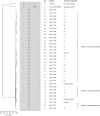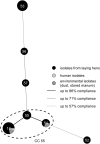Potential Transmission Pathways of Streptococcus gallolyticus subsp. gallolyticus
- PMID: 25978355
- PMCID: PMC4433203
- DOI: 10.1371/journal.pone.0126507
Potential Transmission Pathways of Streptococcus gallolyticus subsp. gallolyticus
Abstract
Streptococcus gallolyticus subsp. gallolyticus (S. gallolyticus subsp. gallolyticus), a member of group D streptococci, is an inhabitant of the animal and human gastrointestinal tract. Furthermore, it is a facultative pathogen which causes e.g. endocarditis, septicemia and mastitis. S. gallolyticus subsp. gallolyticus may be transmitted either directly or indirectly between animals and humans. However, the transmission routes are an unsolved issue. In this study, we present systematic analyses of an S. gallolyticus subsp. gallolyticus isolate of an infective endocarditis patient in relation to isolates of his laying hen flock. Isolates from pooled droppings of laying hens, pooled dust samples and human blood culture were characterized by using multilocus sequence typing (MLST) and DNA fingerprinting. MLST revealed the same allelic profile of isolates from the human blood culture and from the droppings of laying hens. In addition, these isolates showed clonal identity regarding a similar DNA fingerprinting pattern. For the first time, we received a hint that transmission of S. gallolyticus subsp. gallolyticus between poultry and humans may occur. This raises the question about the zoonotic potential of isolates from poultry and should be considered in future studies.
Conflict of interest statement
Figures




References
-
- Schlegel L, Grimont F, Ageron E, Grimont PA, Bouvet A. Reappraisal of the taxonomy of the Streptococcus bovis/Streptococcus equinus complex and related species: description of Streptococcus gallolyticus subsp. gallolyticus subsp. nov., S. gallolyticus subsp. macedonicus subsp. nov. and S. gallolyticus subsp. pasteurianus subsp. nov. International Journal of Systematic and Evolutionary Microbiology. Soc General Microbiol; 2003;53(3):631–45. - PubMed
-
- Sillanpää J, Nallapareddy SR, Qin X, Singh KV, Muzny DM, Kovar CL, et al. A collagen-binding adhesin, Acb, and ten other putative MSCRAMM and pilus family proteins of Streptococcus gallolyticus subsp. gallolyticus (Streptococcus bovis Group, biotype I). Journal of Bacteriology. Am Soc Microbiol; 2009;191(21):6643–53. 10.1128/JB.00909-09 - DOI - PMC - PubMed
-
- Devriese L, Uyttebroek E, Gevaert D, Vandekerckhove P, Ceyssens K. Streptococcus bovis infections in pigeons. Avian Pathology. Taylor \& Francis; 1990;19(3):429–34. - PubMed
-
- Sasaki E, Osawa R, Nishitani Y, Whiley RA. ARDRA and RAPD analyses of human and animal isolates of Streptococcus gallolyticus . Journal of Veterinary Medical science. Japanese Society of Veterinary Science; 2004;66(11):1467–70. - PubMed
Publication types
MeSH terms
Substances
LinkOut - more resources
Full Text Sources
Other Literature Sources

